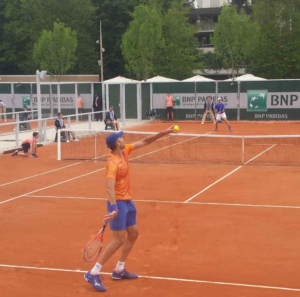Mastering the Pinky Grip: Elevating Your Tennis Serve
The principle of gripping tightly with the pinkies while keeping the rest of the fingers looser, as practiced in Japanese swordsmanship, can be transferred to tennis serves in a way that significantly improves power, control, and fluidity.
In swordsmanship, the pinkies provide a stable base for control and power, while the looser grip from the other fingers allows for smooth, fluid motions. This same concept can be applied to your tennis serve, resulting in a more efficient and effective technique.
Here’s how this soft hands concept can be applied to serving:
1. Power Generation
Just like in swordsmanship, the pinky and ring fingers play a key role in generating power for your tennis serve. A firm grip with the pinkies allows you to channel strength from your arm and core into the racket, ensuring a solid transfer of energy during contact with the ball.
– How to Apply: Focus on gripping the racket tighter with your pinky and ring fingers while preparing for the serve. This grip stabilizes the racket, helping generate more power when you accelerate through the ball. This becomes particularly effective during the wind-up and contact phases of the serve.
2. Fluidity and Wrist Snap
The loose grip in the index and middle fingers promotes flexibility in the wrist, essential for generating spin and allowing the racket to move smoothly through the contact zone. A tight grip throughout all the fingers would limit wrist movement, reducing both spin and racket head speed.
– How to Apply: Keep your index and middle fingers relaxed during the serve motion, allowing your wrist to snap freely through contact. This helps generate topspin, slice, or any desired spin more effectively, while keeping your motion fluid.
3. Control and Accuracy
Gripping tightly with the pinkies while keeping the upper fingers looser provides a strong base for control while allowing for subtle adjustments in the racket’s angle. This combination ensures accuracy without the risk of over-gripping, which can lead to tension and inconsistent serves.
– How to Apply: Focus on keeping a looser grip in the upper fingers during the toss and as you bring the racket through the hitting zone. This allows for fine-tuning of the racket face, helping with better ball placement, especially in crucial moments like second serves where precision is key.
4. Serving Rhythm
A balanced grip helps promote a relaxed, natural rhythm in your serve. The firm pinky grip stabilizes the racket, while the looser upper fingers facilitate a smooth, rhythmic swing, preventing muscle tension and enabling consistent timing.
– How to Apply: Practice serving while focusing on the balance between a tight pinky grip and relaxed upper fingers. This allows you to maintain a calm, relaxed rhythm through the entire serve motion, leading to more consistent contact and timing.
5. Spin and Variations
The wrist flexibility gained from the looser grip allows players to execute a variety of serves—whether it’s adding extra topspin, slice, or kick. The relaxed grip in the upper fingers enhances your ability to control the ball’s trajectory and spin, making your serves more versatile and unpredictable.
– How to Apply: For spin serves, focus on keeping your wrist flexible by maintaining a looser grip with the upper fingers. This will help you impart more spin on the ball, allowing you to execute slice or topspin serves with ease, and make your serve harder to read for your opponent.
By incorporating the principle of gripping tightly with the pinkies while keeping the rest of the fingers loose, you can significantly improve your serve. This soft hands grip helps generate power, enhances wrist fluidity for spin, and increases control and precision.
Applying these tips will lead to a more effective, consistent, and versatile serve, helping elevate your overall game performance.

Take a close look at Karlovic’s grip on his serve, captured during his match against Thommo at the French Open a few years ago. It almost resembles a two-finger grip, reminiscent of the way Gonzales used to serve! Photo credit: Tony Reynolds




Leave a Reply
Want to join the discussion?Feel free to contribute!